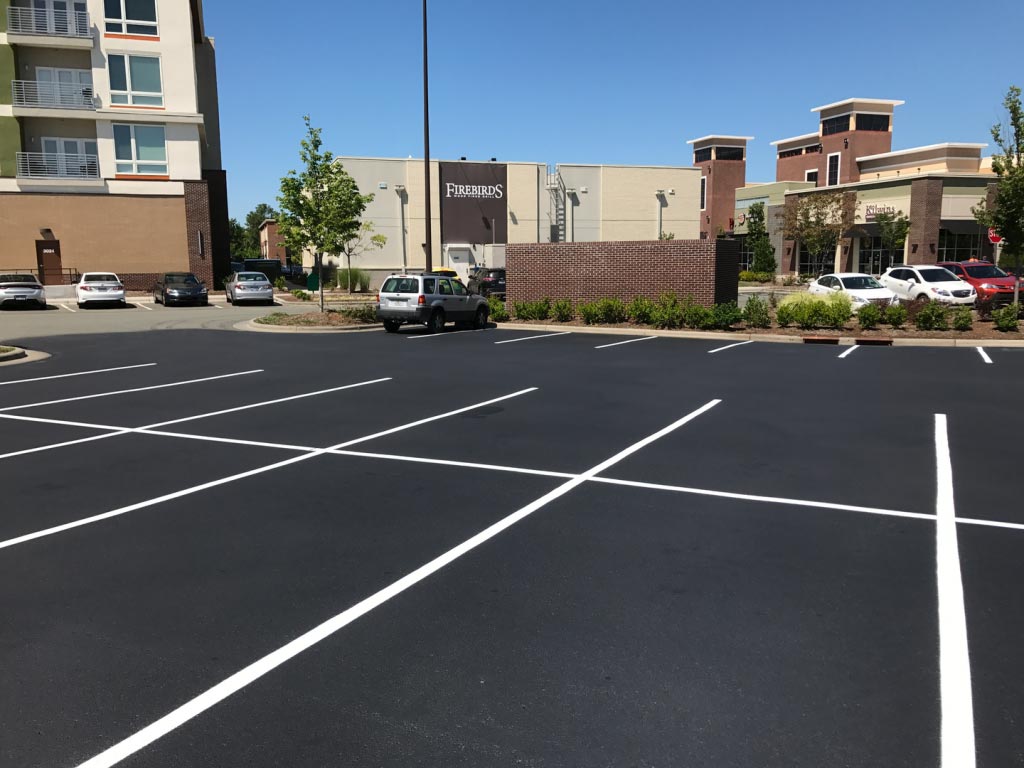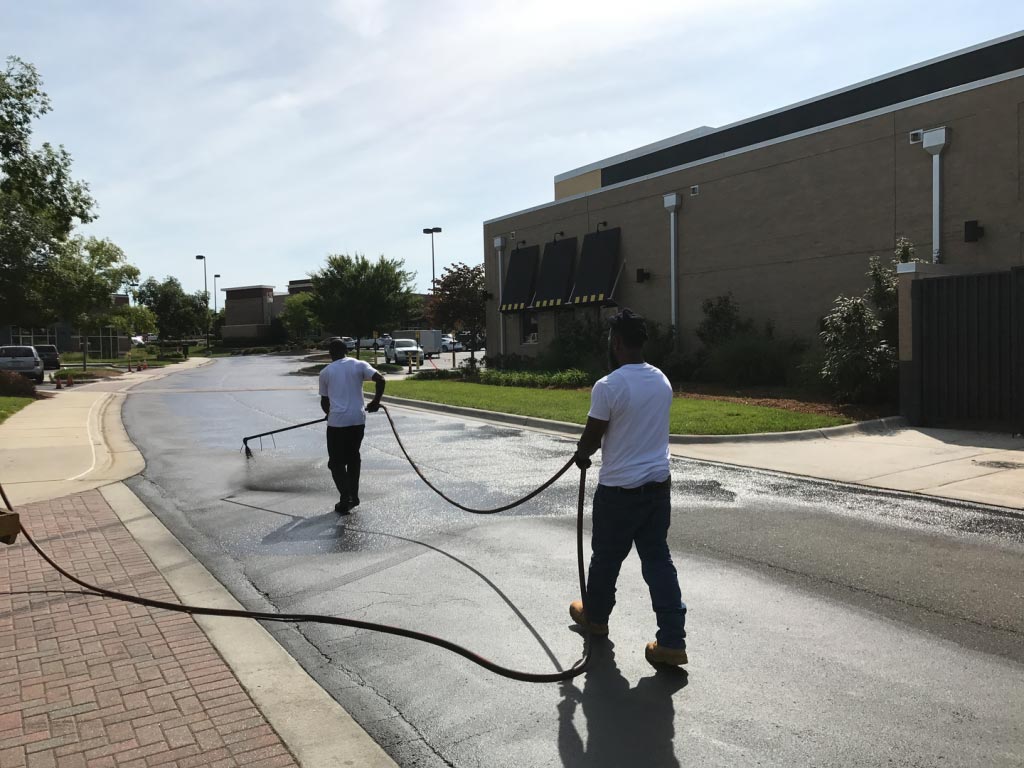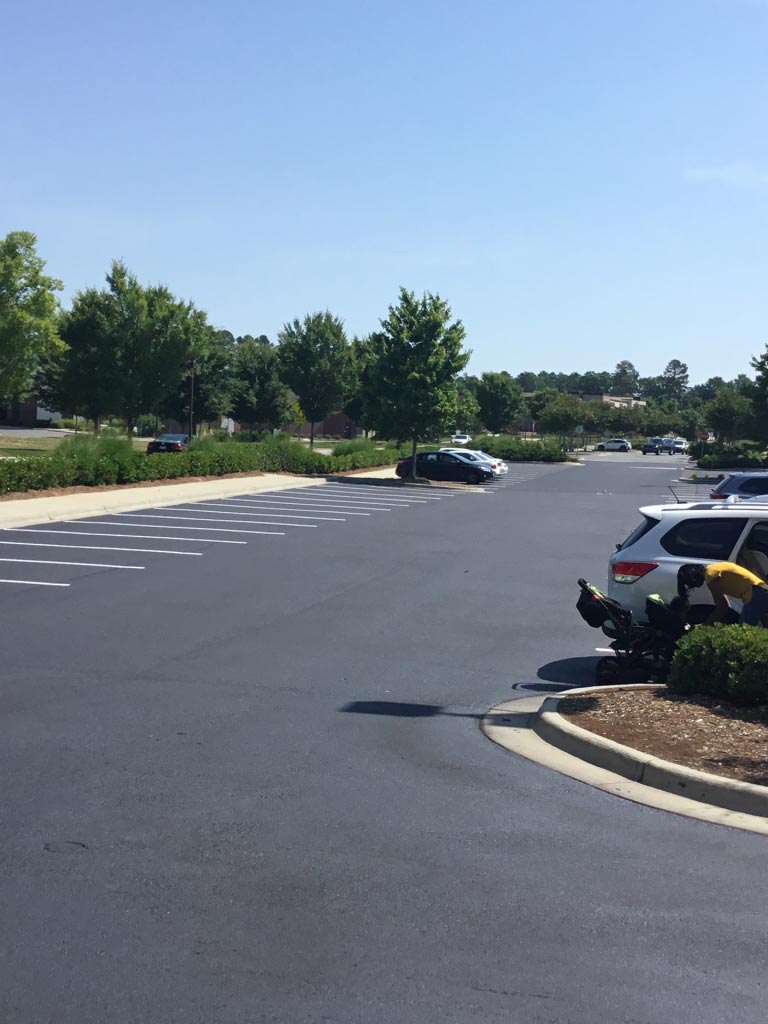
Precision Striping & Lot Restorations applied 14,000 gallons of sealer in two coats and used two ride-on striping machines to apply 2,000 gallons of paint to 8,000 lines.
A boxer who steps up in weight class must make adjustments to be successful. The roundhouse punch that will stagger a lightweight boxer will knock-out a heavyweight because the power behind the punch is so much greater.

A small contractor who steps up in class Maurice Webb says he will be adding thermoplastic markings to his services in 2019, and he expects thermoplastic to quickly account for 50% of the company’s striping work. has to make adjustments as well. While he might be able to withstand a mistake on a small job, that same mistake on a large job can knock the profit right out of the project and even knock the company out of business.
A small contractor who steps up in class Maurice Webb says he will be adding thermoplastic markings to his services in 2019, and he expects thermoplastic to quickly account for 50% of the company’s striping work. has to make adjustments as well. While he might be able to withstand a mistake on a small job, that same mistake on a large job can knock the profit right out of the project and even knock the company out of business.
So when Maurice Webb decided to step up in weight class and bid a 1.3 million-square-foot striping project, he knew what he was facing. And he was ready. That’s because throughout his career Webb has understood that sometimes the key to success is knowing what you don’t know – so you can go learn it.
That’s how Webb approached the eight-years he has worked growing Precision Striping & Lot Restorations, Raleigh, NC, a striping, sealcoating and cracksealing company specializing in small parking lot work.
Last year Webb and his 3-person company took a leap of faith, stepped outside their small parking lot comfort zone, and successfully tackled the Park West Village outdoor mall parking lot in Morrisville, NC. Prior to that his largest job had been an 80,000-square-foot parking lot, and he says jobs between 50,000 and 75,000 square feet “are right in my wheelhouse.”
“Even though we have the equipment and the skill set to sealcoat a million square feet, those aren’t the types of jobs I want to be doing every weekend,” Webb says.
But here’s how he tackled this huge jump in size – and what he learned along the way.
Getting the Job

Park West Village is a multi-retail outdoor mall with a Maurice Webb says he learned through his research that the Park West Village was concerned about environmental issues, so he switched to what he terms an “eco-friendly sealer” in his proposal – which he later learned helped him get the job. “If you realize that’s something the customer cares about then you need to be ready to switch, even if it’s just for that job,” he says. grocery store, movie theater and more than 30 smaller retail stores. Webb and his wife often went to the movies there and the pavement caught Webb’s attention.
“I started thinking that this lot hasn’t been striped since it was paved, and I wondered if they had a guy in mind to do the striping. My thought was, this would be a great striping job,” he says
So Webb researched the mall on Google, learned who the property manager was and set up a meeting. It was a cold call.
Webb says he was a little intimidated as a small contractor bidding a job of this size, “especially since it was a big jump for us. I mean you go into their boardroom to make the presentation and the conference table probably cost more than we made the last month.”
So going into the initial meeting he felt he had to make an impression. “I figured they would appreciate a straight shooter so I was laser-focused on telling them what was going to happen and how it would happen,” he says.
To be able to do that Webb visited the site and did all the measuring in advance, even to the point of visiting some of the tenants to determine their hours of operation. And when he did meet with the property manager he went in armed with a plan that included 30,000 linear feet of cracksealing, 1.3 million square feet of sealcoating, and 8,000 lines to stripe.

“I knew how much sand was going to go into the sealer, how Before many gallons of sealer it would take to put down two coats, and how much paint the lines would require. That was the first time I’d ever done that in advance and it really paid off,” Webb says. “I did that because I wanted them to know that I know about the property. I wanted to get ahead of the customer. That was impressive to them because they said no one had ever done that for them. They knew I was serious.”
Here’s how serious he was.
“I was very adamant about getting partial payments,” Webb says. “No way I can bid and take on a job this big on my own

without their support, so I negotiated up front for payment in three installments: 20 percent upon acceptance, 30 percent about halfway through and the remaining 50 percent upon completion.
Webb was also straightforward – unusually so—about the profit he expected on the job.
“I was very adamant about our profit, too,” he says. Section size was based on how much sealer their 750-gallon trailer-mounted spray unit could apply in a day, so generally between 30,000 square feet and 40,000 square feet each day. Schedules got bumped when weather interfered but otherwise the production went off as planned. “Profit was a theme spoken in the meeting. I didn’t want this to be just a big job that we could say we did. I wanted it to be a profitable big job that we did.”
He says he provided so much detail and was so straightforward that following his presentation there were virtually no questions – and he got the job.
“When I left the room I was really surprised, almost like ‘what just happened in there?’ I thought I had a good chance to get the work but I thought I would have to answer a lot of questions and I was prepared. But that just didn‘t happen.”
Learning What He Didn’t Know
Webb lived with a foster family during his teenage years in Detroit, MI, and says he first striped as a part-time job in high school at age 15. “Getting exposed to striping was an eye-opener for me, and it kept me out of trouble,” Webb says. “The work has literally kept me out of prison so I have a special place in my heart for striping.”
When he started Precision Striping & Lot Restorations in 2010, he started with nothing. His first piece of equipment was a walk-behind sprayer that used inverted spray paint cans to apply the paint. “My first job didn’t go very well. In fact it was terrible,” he says. “I realized I had a lot to learn.”
So while running his fledgling striping business on the side, he went to work striping for a larger contractor. “I tell people I was a secret agent because while I was with them and doing their striping I was learning everything I could about as much as I could – like sealcoating and cracksealing,” he says.
That experience also reinforced something he had suspected for a while, that he wasn’t meant to be a crew member. “I realized I was born to be an entrepreneur,” he says. “Some people are happy when they’re part of a crew but I realized I wanted to be the person that hired the crews and got the work. I wanted to own the business.”
So he left that job and bought a used striper for $500. “I used that machine until I broke it,” he says.
And it was about this time that Webb realized he was “The job required a lot of cutting in throughout the property, but once

that was done we were off and running,” says Maurice Webb, president.at a crossroads. He was married and he had children to support. He was bidding and winning work, getting the opportunities he needed to be successful.
“I learned how to market myself for jobs that were good for me,” Webb says. “I realized that as a small contractor I was suited to small jobs and I realized new construction was something that fit my business well. I realized that I wanted to work with people who valued relationships, whether it was a property manager or another subcontractor.
“I felt like I was off and running, and I felt ready to go. I had the skill set, but my knowledge hadn’t caught up to the point where I could take advantage of the opportunities I was getting. My knowledge still hadn’t come to the point where I could manage a company. I had to decide if I was going to be a business owner or if striping was just going to be a hustle for me. I realized I needed to learn how to run a business.”
So in 2015 he did two things that would help determine his success: He attended a National Pavement Expo show and he took a job striping for another contractor “to learn things I didn’t know. They knew I had my own company and they knew I wasn’t joining them to be there forever, but they needed a skilled striper so it worked out for both of us.”
After six months he was back on his own, and by 2017 he had enough work to keep his crew busy for eight months. In 2018 the company generated 45% of its sales from pavement marking, 40% from sealcoating, and the remaining 15% from a mix of cracksealing, signage, parking stops etc. After eight years in business Precision Striping & Lot Restorations has yet to cross the $1 million mark – but they’re close.
“I have a mentality of ‘just do what’s in front of you and do it the best you can’,” he says.
Scheduling 1.3 million square feet
And what ended up in front of him last year was Park West Village.
Unlike his small job, the Park West Village project required detailed plans and schedules to accommodate all the businesses. The property handles between 20,000 and 50,000 vehicles each month, so traffic control and pedestrian control was a big part of early planning and of each day’s activity.
“I learned the calendar is the most important tool because you can sit there looking at it with the property manager and plan the entire job out,” Webb says. “We rolled in some time in for bad weather and we had to work around the property’s schedule, but we sat down and we talked about all that. They had a festival coming in and we needed to be finished before that so that was the target end date and we backed out the schedule from there.” They agreed on a 45-day window to complete the job – and Webb and crew finished on time requiring only 33 working days.
Because it would be too difficult to jump around the parking lot to try to work around every store’s hours, Webb divided the project into three phases. Each phase was divided into sections and each section was scheduled for completion in one or two days.
Phase 1, for example, covered roughly 300,000 square feet and included 50,000 square feet in front of a grocery store. He and the property manager decided that area should be done first since the store had the most traffic, so he color-coded that area red and scheduled it for two days. Each section size after that was 30,000-40,000 square feet — and that size was determined by how much Webb’s 750-gallon, trailer-mounted sealcoating spray unit could apply in a day.
Checking-in with the Customer
The property manager had a copy of the color-coded map, and Webb occasionally texted screen shots from the map on his iPad to the customer to show their progress. But one change he will make on future longer-term projects is to check-in with the customer more frequently.
“We found that it’s a good idea when working with a customer over a longer period of time just to make sure the customer is getting those small satisfactions throughout the job. ‘Hey, does everything check out?’ ‘Are you satisfied with the section finished today?’ It makes them feel engaged in the process and they can feel confident that they picked you,” Webb says. “It’s easier to call them and tell them where you are than to have them call you and ask what the status is. I didn’t do as well as I should have on this job but I guarantee you I will do it from now on on every bigger job.”
He says checking-in throughout the job also means you don’t have to wait for the end of the entire project to get their approval. “You can fix anything they want right now instead of waiting for the end of the job and having to go back over the whole property,” Webb says. “That way you know that each phase of the project has already been completed and approved.”
Meeting the Schedule
His crews devoted the first three days on the job to cracksealing to give the company a head start. “We cracksealed as much of the area as we could those first three days, starting where the first section of Phase 1 would be. Then we cracksealed the remainder of the lot on a couple of days where it was too cold to sealcoat.”
Webb says he initially planned to use a drop tank for the job but they more he looked into it and once he planned the job out he realized a few days of bad weather would have cost him any savings he might have made. “If we ran into weather where we couldn’t sealcoat – and we did – we would have been paying for the drop tank on days we didn’t work. So not using a drop tank ended up working to our advantage.”
The company set up a staging area in part of the parking lot that was already leased to a construction firm to house 53-foot-long storage trailers for an apartment complex being built across the street. Rather than have the trailers moved to sealcoat the area then moved again once their area was completed, he scheduled phases and sections so those containers would have to be moved only once — at the very end of the parking lot work. That made the area ideal for staging the job.
Precision Striping’s crew started at 5:00 a.m. – and at 4:00 a.m. on days when the temperature was going to be hot. “That way we’d be rolling in terms of sealer by 8:00 a.m. and we could be finished and off the pavement by 1:00 or 2:00,” Webb says. “My goal was to get the guys off the job by 2:00 so they weren’t working in the heat and so we didn’t have to worry about heat exhaustion. We all found it great, even though we were starting so early. It was cooler, there was less traffic and by the time we started sealing the sun was up and it was drying quickly.”
After the crew was finished each day Webb drove the sealcoating trailer 10 minutes to the sealer supplier, filled it up and drove it back and parked it in the staging area so it was all ready for the next day’s work.
He says he paid a bonus to his crew occasionally over the 45 days to help keep them focused and energized to get the job done because it was a grinding process for everyone. “There was a lot of work and they were fatigued so I thought a bonus during the job was appropriate and it helped,” Webb says. “The guys appreciated it and I wanted to make sure they knew that I appreciated their good work they were doing.”
Webb says the parking lot required very little stencil work, and they got lucky because the original layout was a good one and the old lines were visible through the sealer. “We just chalked them to keep them straight and then we striped,” he says.
Impact of a Large Job
Webb says that taking on such a large job required all his resources – and it did impact other work the company had on the books.

“When a company like mine takes on a big job like this Maurice Webb those small jobs have to get pushed aside or delayed to make this schedule,” he says. “In some cases when I had to get a smaller job done we had to pull people off this job and I felt like we were cheating them a bit – even though that really wasn’t the case.”
He says that on the whole he’d rather do 10 jobs with the same square footage as one big job. “I like to get in and off a property as much as possible and I like to see the finished job,” Webb says. “This job never felt to me like it was finished. We’d finish a section but until the very end we always knew we were coming back the next day to do another section. I found it mentally fatiguing – it’s more a marathon where the smaller jobs are more a sprint.”
He says he also likes to take the smaller jobs because he can take and work other smaller jobs in and around each other. “Big jobs are all consuming. You have to take into account other projects that have to take a back seat while you’ve devoted all your attention to this big project.”
Phone a Friend!
Included in Precision Striping & Lot Restorations’ planning was the hiring of a sealcoating subcontractor to help complete the 120,000-square-foot delivery and loading dock area where no striping was needed.
“It was an area we had to get done quickly because we couldn’t close it down for two days. So we hired a sub and took two tankers back there and cut it in and they followed us and then we followed them,” says Maurice Webb. “You have to be willing to ask for help if you need it. Bring in a sub if you need the help to keep on schedule. Don’t be selfish.”
He says that including sealcoating the delivery and dock area and hiring a sub to help a few days when his sealcoating unit was being repaired, Webb subcontracted out $10,000 worth of work on the Park West Village project.
How NPE Helped with Growing Pains
In the midst of his growth, Maurice Webb attended his first National Pavement Expo – and he says what he learned opened his eyes.
“I started to realize this was a big deal, that what I was doing was running a real business and that I needed to approach it like a business that I could grow,” he says. “I took all sorts of sessions even on things I wasn’t doing just to learn and listen to how other people were doing things.”
He says the conference helped him on the Park West Village job because he could apply much of what he’d learned at NPE. “When I walked into that boardroom I wasn’t a novice. I’d heard people at NPE talk about how they handled large jobs and I’d paid attention to all the things I wouldn’t have thought about on my own like cash flow, the time involved and how that affected other jobs, and how to work with a client.”
He says NPE has taught him that businesses are constantly experienced growing pains. “You think you have a handle on something and you probably do, but then you look over here and you realize that as the company has gotten bigger and busier there are new growing pains you have to deal with.
“Before I used to be thinking about what piece of equipment I need to get but now I’m thinking more about the people who work for me,” he says. “I’m learning how to be a better employer. I’ve always paid people on time, which of course is very important, but I’m learning that how people visualize the company they work for and where they think the company is headed in the future are just as important.”
Stepping up in Size: 13 Tips to Get and Run the Big Job
1. Obtain measurements, talk with tenants, and put together a plan even before your first visit to the client. “It doesn’t have to be airtight but at least have a plan as a starting point.”
2. Be confident. “You’re the professional and you know what you’re doing. Convey that to the client.”
3. Use the material the company wants; switch if you have to – even if you don’t normally use that product. Through his research Maurice Webb learned Park West Village was an environmentally conscious property so he suggested use of what he terms an “eco-friendly sealer” that he doesn’t normally use. “If you know the customer cares, use it because that sends a really important message.”
4. Insist on partial payment in advance to buy materials and another partial payment partway through the job to make meeting your payroll easier.
5. Make sure to profit from the job – don’t just do it so you can put a high-profile job on your resume and website.
6. Use a calendar to plan the job with the property manager.
7. Get yourself a good weather app, one that provides hour-by-hour forecasting and humidity – even if you have to pay for it.
8. Ask for help if you need it. Friendly competitors are more than willing to pitch in.
9. Recognize that customer relations will be different. You will be dealing with more tenants and you will be dealing with them and the property manager over a longer period of time. “It’s not like a job where you see the customer one or maybe two days and then you’re on to the next project,” Webb says. “I wasn’t used to dealing with customers over a long time and I had to learn to be more patient.”
10. Take care of your crew. If they’re not used to working on larger jobs the experience will be stressful, so provide incentives to keep them focused and energized to be productive and produce quality work.
11. Communicate regularly with the property manager. It’s easier (and better) for the contractor to reach out to the property manager than to wait for the property manager to reach out to the contractor.
12. Recognize the impact a large job will have on your smaller jobs.
13. Have the customer approve each section or phase as it’s completed so you can fix anything the client wants and be done with that area. This makes it easier to get a final approval and quicker payment once the job’s done.





